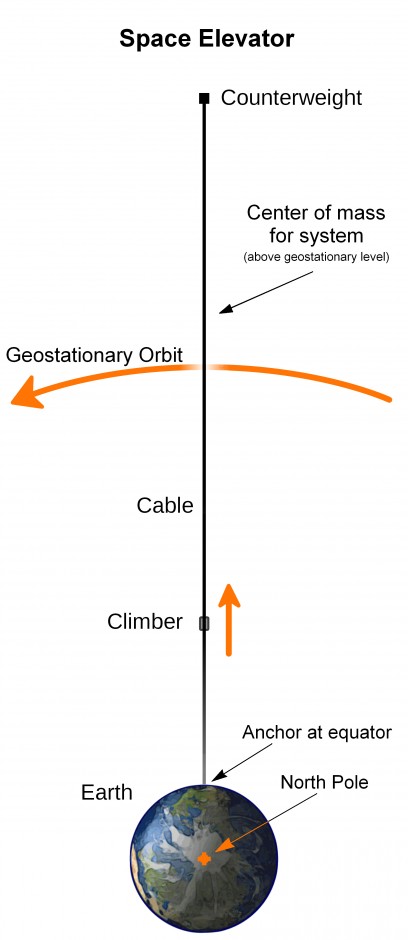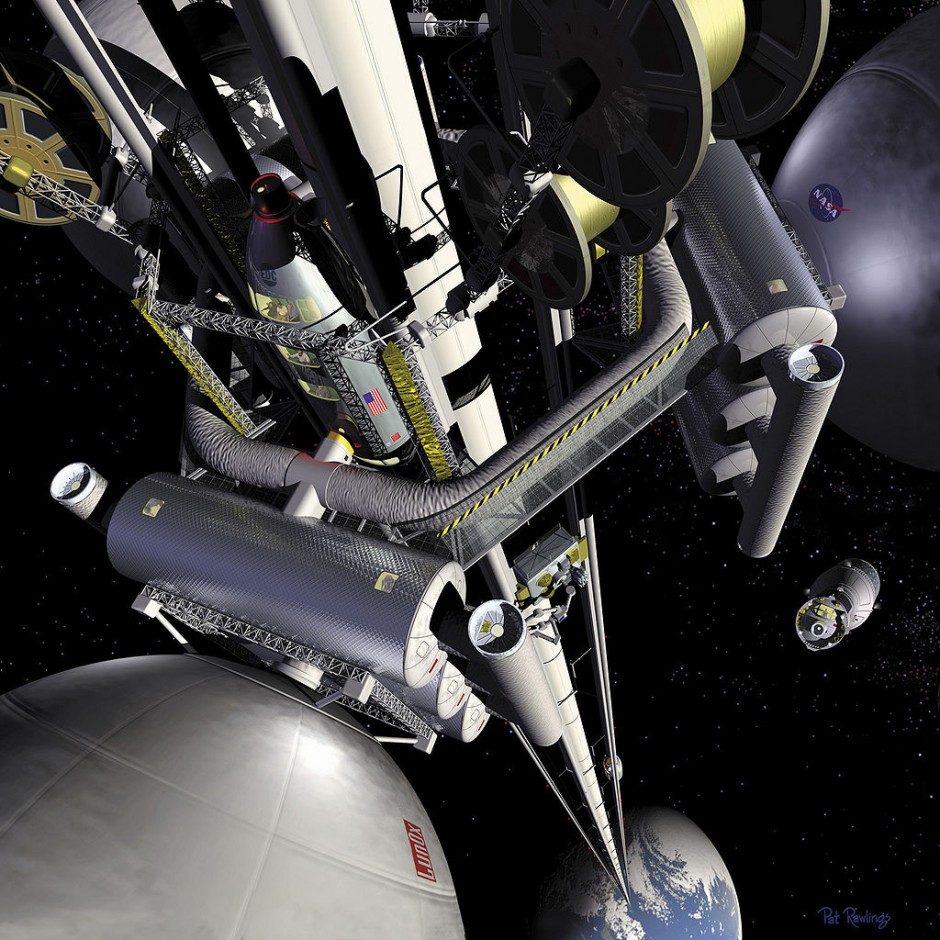From Star Trek to Arthur C. Clarke, machines that carry humans into space inside a cable-driven chamber – space elevators – have remained in the realm of science fiction. However, recently a Japanese construction company revealed it has aspirations to actually build such a device, claiming it could be operational as early as 2050. Despite assurances from its backers, the project remains scientifically implausible for a number of reasons, not least because travelers would face deadly doses of radiation as they climb through Earth’s atmosphere.
Tokyo-based Obayashi Corp. proposes to carry space tourists to a station a tenth of the distance to the moon, or roughly 36,000km above Earth’s surface, using a solar powered space elevator attached to a carbon nanotube pulley. The device would also allow researchers to continue yet further into space, likely as far as the counterweight at the end of the cable, located a whopping 96,000km from Earth.
Such altitudes are considered very high, even in the context of the most ambitious space projects. For example, the International Space Station orbits at 330km above Earth, whereas the forthcoming Virgin Galactic shuttle will briefly fly customers at an altitude of 110km. In comparison, the average passenger jet cruises at a height of 10km.
But Obayashi is no stranger to ambitious construction projects. They are the main contractor on Tokyo Sky Tree, the world’s tallest self-supporting tower (635m), and its international portfolio includes the Dubai Metro system and Stadium Australia, used for the Sydney Olympics.
“Not simply a dream”
Renewed enthusiasm for the space elevator project hinges on a number of crucial technological developments and methodological insights, including the carbon nanotube technology used to construct the cable. Invented in the 1990s, it is many times stronger and more flexible than steel.
The elevator car, or climber, would travel on the cable using magnetic linear motors, which would use an alternating magnetic field to cause the coil to move. As for the station, it would have to be strategically placed in geosynchronous orbit, that is, circling in sync with the spinning of the Earth, and thereby always remaining in the same spot relative to its base on the ground.
Little is known about many of the project’s finer practical details, including the potential cost, likely sponsors, and where to build it. “At this moment, we cannot estimate the cost for the project,” an Obayashi official said to Wired. “However, we’ll try to make steady progress so that it won’t end up as simply a dream.”
Space tourism has recently been heavily featured in the news, with Virgin Galactic expecting to test its first spacecraft beyond Earth’s atmosphere this year and promising commercial suborbital passenger services as soon as by 2014. However, unlike Virgin Galactic, which will only carry six passengers at a time, its designers claim the elevator could carry up to 30 people and travel at a maximum speed of 200km/h. For comparison, the traditional Space Shuttle travelled at 28,000km/h.

Overview diagram featuring an elevator car (climber) traveling along a reinforced cable towards the counterweight. A recent proposal would place a space station approximately a third of the distance between Earth and the counterweight at the cable's end (Source: Wikimedia)
Avoiding lethal radiation a major challenge
Although the space elevator concept is alluring, the project faces important scientific challenges. For example, without improved protection for travelers, they would be subjected to lethal doses of ionising radiation as they travel through two concentric rings of charged particles surrounding the Earth, known as Van Allen belts.
Van Allen belts span a range of approximately 1,000-20,000 km altitude from Earth’s surface. Therefore, in the proposed space elevator, passengers would spend several days within the belts, exposing them to over 200 times the radiation experienced by the Apollo astronauts. “They would die on the way through the radiation belts if they were unshielded,” said Anders Jorgensen to New Scientist. He is the author of a new study on the subject and a technical staff member at Los Alamos National Laboratory, New Mexico, USA.
Jorgensen’s sentiments are echoed by Iannis Dandouras of the European Space Agency. “The most intense radiation levels are in the Inner Radiation Belt (IRB), which extends typically in altitudes from ~1,000 to ~20,000 km above the equator. At the announced ascension speed of 200km/h, it would take the space elevator passengers almost four days to go through the IRB, receiving during this time an extremely high accumulated radiation dose, which would present a very high risk for their health (or even for their survival, if not properly shielded). The IRB contains a very intense population of energetic ions, trapped in the Earth’s magnetic field, each of these ions having an energy of typically several tens of MeV (megaelectronvolts). In addition to this, there is also the Outer Radiation Belt, populated mainly by energetic electrons having an energy of typically several MeV, and extending out to almost the geostationary orbit. In the 1960s and 1970s, the Apollo astronauts did not face such a hazard, due to the very quick transit time through the radiation belts (transit through the IRB was less than an hour),” he commented in a recent email interview.
“Humans have long adored high towers”
Proposed solutions to the radiation problem come with important consequences. By moving the elevator’s base off the equator, the most intense part of the radiation belts could be avoided. However, centrifugal forces would cause the elevator’s cable to veer south – if located, for example, at a latitude of 45° North, it would run nearly horizontally for thousands of kilometers through Earth’s atmosphere and thus be weakened by weather-related stresses, such as high winds, hurricanes, and tornadoes.
Another option would be to have a radiation shield stationed along the cable, to be picked up by the elevator when it reaches the belts, but such a shield would be heavy and disrupt the natural motion of the cable.
A further option is to generate magnetic fields around the climber that could shield the habitat module as it climbs through space. However, this would require a great deal of power, difficult to transfer to such altitudes.
NASA has also toyed with the idea of space elevators. According to their concept, the base tower would be approximately 50km tall, with a counterweight placed beyond geostationary orbit – possibly even attached to an asteroid.
Despite the daunting task of overcoming these major practical challenges, Obayashi Corp. remains confident of their ability to deliver humanity’s first space elevator. “We were inspired by the construction of Sky Tree. Our experts on construction, climate, wind patterns, design, they say it’s possible. Humans have long adored high towers. Rather than building it from Earth we will construct it from space,” commented Satomi Katsuyama, the project’s leader, at a recent press conference.
By Edvard Glücksman, EGU Science Communications Fellow

